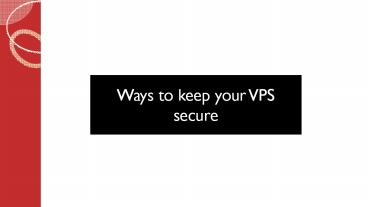Ways to keep your VPS secure - PowerPoint PPT Presentation
Title:
Ways to keep your VPS secure
Description:
The topic of web hosting security appears to be ubiquitous these days, a concern not only among major businesses but also among individuals with an online presence. With stolen personal and financial information, lost client data, and destroyed website content, cyber risks are highly serious and should not be taken lightly. – PowerPoint PPT presentation
Number of Views:21
Title: Ways to keep your VPS secure
1
Ways to keep your VPS secure
2
Table of Contents
- Introduction
- Ways to keep your VPS Secure
- Conclusion
3
Introduction
- The topic of web hosting security appears to be
ubiquitous these days, a concern not only among
major businesses but also among individuals with
an online presence. - With stolen personal and financial information,
lost client data, and destroyed website content,
cyber risks are highly serious and should not be
taken lightly.
4
Ways to keep your VPS secure
- Keeping your VPS secure entails essential ways,
therefore you must do the following to keep them
safe - Change your default SSH Login
- Use the most up-to-date software versions
- Keep an eye on your VPS server logs
- Ascertain that your server is malware-free
- Safeguard against brute-force attack
- Perform Backups
- Use SSL certificates for everything
5
Change your default SSH Login
- Many VPS users connect to their servers through
SSH, or Secure Shell, which is a technique for
remote computer-to-computer communication. - If you use SSH to connect to your server, you
risk being a victim of a brute-force attack. - A brute force attack occurs when someone attempts
to access your SSH using a variety of popular
passwords. - As a result, we recommend replacing the default
SSH 22 port login password with a customized one. - Strong passwords often contain a combination of
upper and lowercase letters, numbers, and
non-alphanumeric characters.
6
2. Use the most up-to-date software versions
- Without a doubt, the older the software version,
the more vulnerable you virtual server becomes. - Fortunately, installing the necessary updates for
your operating system is as simple as few mouse
clicks. - You should also consider automating this
operation. And, depending on the operating
system, you'll probably upgrade the system with
apt-get for Debian and Ubuntu for CentOS. - This may be done automatically with cron jobs, a
Linux-based software that schedules a command or
script on your VPS to run at a specified time and
date, or through your control panel.
7
3. Keep an eye on your VPS server logs
- Keeping track of your server logs allows you to
remain on top of what's going on with your
virtual private server. - If you monitor your VPS systems and software, you
will be more prepared if an issue arises. - If you actively monitor events, resource usage,
traffic levels, user activity, and
software-generated faults, you will be better
prepared to deal with problems. - It is also recommended that you establish email
notifications for any cautions and issues so that
you can stay up to date in real time.
8
4. Ascertain that your server is malware-free
- In addition to setting a firewall to safeguard
incoming traffic, you should consider monitoring
the files that have already been and are now
being uploaded to your VPS for any
vulnerabilities. - As a result, you'll require reliable anti-virus
software on your VPS, as its signatures must be
updated on a regular basis. This is also a good
way to detect suspicious behavior and quarantine
unwanted data.
9
5. Safeguard against brute-force attack
- When hackers find weak passwords, they get total
access to your virtual private server (VPS).
Unfortunately, having a strong password is no
longer enough. - You will also require tools to detect brute-force
attacks and block illegal logins. - An excellent example is cPhulk, a
cPanel-integrated function. - After a number of failed login attempts, cPhulk
aids in restricting logins and inhibits not just
cPanel logins but also WHM, FTP, and email-based
logins.
10
6. Perform Backups
- Backups are necessary for all types of hosting,
not only VPS hosting. - Backups should preferably be performed outside of
the server in case something goes wrong with it. - However, some service providers provide backup
capabilities as an add-on service.
11
7. Use SSL Certificates for Everything
- SSL certificates allow you to establish an
encrypted connection between the server and the
client, ensuring that your privacy is not
violated. - SSL certificates are required for any type of
hosting to keep your sensitive data safe, whether
you are transmitting files, sending emails, or
entering your login credentials. - However, significant technical knowledge is
required to successfully implement SSL
certificates. - In this case, it is worthwhile to hire a system
administrator to manage everything for you and
give you with additional piece of mind.
12
Conclusion
- To summarize, regardless of whether you pick
shared hosting, VPS hosting, or dedicated hosting
for your website, security should always be a top
priority. - Using difficult-to-guess passwords, enabling
two-factor authentication wherever possible,
avoiding the use of illegal software, and not
opening email attachments from people you don't
know are all examples.
13
Thanks!
www.htshosting.org

